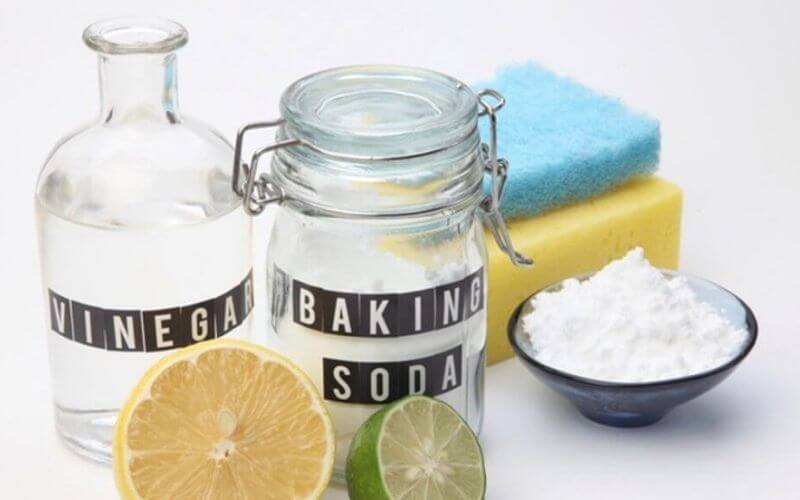The electric kettle might just be my favorite kitchen appliance because of how useful it is when you’re in a hurry. It is the ultimate tool for quick and convenient meals; even more so than instant pots and rice cookers.
They are perfect for small, single servings and are great at making tea, a quick cup of coffee, instant oatmeal, soup, ramen, and even potatoes. The electric kettle is right up there with microwaves when it comes to easy, affordable, and quick meals.
There’s just one solitary issue.
Electric kettles need regular cleaning and maintenance so that they work properly. Cleaning any type of kettle requires more thought and care than anticipated so many people put it off until the mineral buildup gives them a disgusting cup of tea.
So today I’m going to dish out the secrets on how to clean electric kettles. Besides telling how often you need to be giving your kettle a deep cleaning, this article will show you how to clean tea kettles, as well tips on keeping your kettle cleaner in the long run.
What Makes Electric Kettles Dirty?
So what’s making your boiling hot water taste all gross? There are two main sources for the funky smell ruining your morning Earl Grey:
Mold:
If your kettle has a filter, you need to clean or change it frequently. Otherwise, the damp interior is the perfect place for mold to grow and thrive.
This can also happen if you leave water in your kettle often. This is a pretty serious issue, as the mold can make you sick.
Mineral Buildup:
When you use your electric kettle, the minerals from the tap water (especially hard water) build up inside it. This buildup is called kettle fur and alters the taste of the water. Because of this, you need to descale your kettle every few months.
How often depends on the frequency with which you use your water boiling kettle. If you use your kettle as a hot pot water boiler, you may have to descale it every other month.
Things You Need to Clean Electric Tea Kettles

To get a clean stainless-steel kettle (or any kind of electric kettle for that matter), you’ll need a couple of things first. Before you start, gather these cleaning tools:
White vinegar or lemon juice or citric acid powder
- Baking soda
- Dishwashing liquid or mild detergent
- Soft scrubber pad or bottle brush
- Microfiber cloth or soft dish towel
How to Clean Electric Kettle
This guide will tell you how to deep clean electric kettles with affordable products and very little elbow grease. It will work for almost all conventional electric kettles, like KitchenSmith electric kettle, Farberware electric glass kettle, or Epica electric kettle.
Descale the Kettle with Vinegar, Lemon Juice or Citric Acid:
Fill around half the kettle with a 1:1 solution of water mixed with and an equal amount of distilled white vinegar or lemon juice. If you are using citric acid powder, use two tablespoons for half a kettle of water. Bring the solution to a full boil.
If the kettle doesn’t shut off automatically, turn it off. Let the acidic solution sit for at least 20-30 minutes. Then, empty the solution into your sink.
Unplug the Kettle:
After that, you need to unplug the kettle. If the kettle comes with a detachable filter, remove it from inside the kettle.
Clean or Replace the Filter:
If your model has a water filter or filter cartridge, clean the filter following the manufacturer’s directions (like the Hamilton Beach electric kettle manual).
Most filters are metallic and can be cleaned by soaking in distilled white vinegar diluted in hot water for at least five minutes. Scrub with the bottle brush, sponge, or scrubbing pad and rinse with fresh water.
If your filter is disposable, throw it out and keep a new one ready at hand.
Clean the Kettle Interior:
Use a non-abrasive scrubber, sponge, or soft-bristled bottle brush to scrub the inside of the kettle. This loosens any mineral build-up, dirt, and mold that remains inside.
Focus on the areas around the spout where mineral build-up tends to be quite heavy. Dipping the brush or sponge in pure vinegar, baking soda, or dishwashing liquid can help remove build-up around the spout.
Clean the Kettle Exterior:
Gently wipe the exterior of the kettle with a soft sponge or scrubber soaked in a mix of warm water and a little dishwashing liquid to remove any smudges or grease. You can even dip the sponge in some baking soda to loosen stubborn dirt.
After the exterior is clean, wipe the kettle dry with a clean dish towel microfiber cloth to remove streaks and smudges.
Final Rinsing:
After all, the dirt is removed and you are satisfied with how clean the inside of your electric hot water kettle, reassemble the parts. Fill around half the kettle with water and bring it to a boil.
Discard the water and repeat this rinsing step until the water doesn’t taste or smell like vinegar or dishwashing liquid. It will also remove any loose bits of mineral remaining in the kettle.
Cleaning an Electric Water Heater Kettle without Vinegar
Don’t have vinegar? You can still get a squeaky-clean kettle.
Use Lemon or Lime Juice:
Squeeze the juice from 2-3 lemons or limes. Mix the juice with an equal amount of water, enough to fill half your kettle.
Cut up the lemon slices and add to the solution. Bring the kettle to a boil and leave it standing for at least 30 minutes.
Use Coke or Soda:
Your favorite fizzy drink can descale your electric kettle too. The solution is acidic and can handle mineral deposits.
Fill three-quarters of your kettle with the drink and bring to a boil. Let it cool for 30 minutes before disposing of.
Use Citric Acid Powder:
Fill half the kettle with fresh water and boil it. Then add 2 tablespoons of citric acid powder to the boiling water and let the kettle stand for 20 minutes before emptying the mixture.
Use Baking Soda:
Fill half the kettle with water and 1-2 teaspoons of baking soda. Bring the mixture to a boil and then let it soak for 20-30 minutes. Pour out the solution and boil some fresh water in the kettle.
Use a Kettle Cleaning Product:
There are lots of commercial kettle cleaners available. Follow the instructions mentioned on the packaging; you generally dilute the cleaner with water in the kettle and bring it to a boil.
Let it soak and then dispose of the solution. Then boil fresh water and discard until there are no lingering odors in the kettle.
Ways to Maintain Your Electric Kettle
By now you know all the methods on how to descale electric kettle and how to clean inside of tea kettle. Let’s move onto how you can keep it clean for longer.
- Don’t leave water sitting in your kettle. Only boil the amount of water you need. Otherwise, pour the boiled water into bottles, jugs, or pitchers after the water has cooled.
- Try to use distilled water instead of tap water, especially if your area has hard water.
- Never submerge your electric kettle in water, or hold it under running water. This will damage the heating element.
- Clean the outside of your kettle every few days to keep the exterior polished and shiny.
- Descale your kettle every 3 months, if not more often.
- Do not use harsh abrasives like steel wool or heavy-duty scrubbers as this can damage the kettle.
- Do not plug in an empty kettle. Besides wrecking the heating element, it can also start a fire.
- Do not use the kettle to boil things like milk, tea, or broth, as it can ruin the filter and make it harder to clean the kettle.
Got Some Questions?
Below you’ll find answers to questions we get asked frequently about cleaning electric kettle.
01. How Do I Descale a Kettle?
You can descale a kettle boiling a solution of water and vinegar/lemon juice/citric acid/baking soda/commercial descaler. Once it has reached a boil, let the mixture do its job for 20 minutes before disposing of it.
02. How Do I Clean the Inside of a Glass Kettle?
The best way to clean a glass kettle is to boil a mixture of white vinegar and water in it. You can also use a very soft bottle brush and a mild dish detergent. Avoid using abrasive materials as this can leave scratches on the glass.
03. Does Boiling Water Kill Mold in the Kettle?
Boiling water for sufficient time will kill mold and its spores effectively. Adding things like vinegar makes the process more efficient.
04. Is Boiling Vinegar Safe for the Electric Kettle?
Boiling vinegar in the kettle won’t damage it as it is diluted in water. If you are worried about tasting vinegar in your instant oatmeal later, boil water in the cleaned kettle and discard it. Repeat this until the water loses the taste/smell of vinegar.
In Outline
Electric kettles, like many other kitchen appliances, need a bit of extra TLC to keep them working properly. It may seem annoying, but doing so will extend the lifespan of your kettle.
Since you now know how to clean electric kettles, you won’t dread the descaling process. Sure it’s annoying, but it will make your tea taste so much better!






